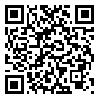Volume 20, Issue 6 (1-2022)
TB 2022, 20(6): 16-26 |
Back to browse issues page
Research code: 5491
Ethics code: 1398.748
Download citation:
BibTeX | RIS | EndNote | Medlars | ProCite | Reference Manager | RefWorks
Send citation to:



BibTeX | RIS | EndNote | Medlars | ProCite | Reference Manager | RefWorks
Send citation to:
Chaleshgar kordasiabi M, Abbasi shavazi M, Karimi O, Hasanpoore yolme S, Lakhi H, Nikokaran J. Happiness and Self-efficacy among Students of Mazandaran University of Medical Sciences. TB 2022; 20 (6) :16-26
URL: http://tbj.ssu.ac.ir/article-1-3271-en.html
URL: http://tbj.ssu.ac.ir/article-1-3271-en.html
Mosharafeh Chaleshgar kordasiabi * 

 , Masoumeh Abbasi shavazi
, Masoumeh Abbasi shavazi 

 , Omolbanin Karimi
, Omolbanin Karimi 

 , Soheila Hasanpoore yolme
, Soheila Hasanpoore yolme 

 , Hanife Lakhi
, Hanife Lakhi 

 , Jalal Nikokaran
, Jalal Nikokaran 




 , Masoumeh Abbasi shavazi
, Masoumeh Abbasi shavazi 

 , Omolbanin Karimi
, Omolbanin Karimi 

 , Soheila Hasanpoore yolme
, Soheila Hasanpoore yolme 

 , Hanife Lakhi
, Hanife Lakhi 

 , Jalal Nikokaran
, Jalal Nikokaran 


mazandaran university of medical sciences , m.chaleshgar@mazums.ac.ir
Abstract: (1287 Views)
Introduction: Happiness is one of the most effective factors in economic, cultural, social, and political development in a society that reduces family problems, divorce, increased academic achievement, job engagement, and production. This study aimed to determine the relationship between self-efficacy and happiness variables with some demographic variables among a group of students.
Method: This cross-sectional study was performed on 371 students from Mazandaran University of Medical Sciences who met the inclusion criteria and selected by simple random sampling method in 2018-2019. The data were collected using Oxford Happiness Inventory (OHI) and General Self-efficacy Scale (GSE). Data analysis was performed by SPSS23 using student t-test, one way ANOVA, and Pearson correlation tests.
Result: The mean age of the subjects was 22.23 ±2.95 years, the mean score of happiness was 28.65 ±14.81, and the mean score of self-efficacy was 60.5 ± 9.44. The variables of age, sex, and education were significantly associated with happiness (P <0.05). Self-efficacy was also significantly associated with age, sex, marital status, and educational level (P <0.05).
Conclusion: Some demographic variables are effective in happiness and self-efficacy in students. In order to promote mental health and the importance of happiness in students, it is recommended to assess these variables, and then take appropriate planning strategy.
Method: This cross-sectional study was performed on 371 students from Mazandaran University of Medical Sciences who met the inclusion criteria and selected by simple random sampling method in 2018-2019. The data were collected using Oxford Happiness Inventory (OHI) and General Self-efficacy Scale (GSE). Data analysis was performed by SPSS23 using student t-test, one way ANOVA, and Pearson correlation tests.
Result: The mean age of the subjects was 22.23 ±2.95 years, the mean score of happiness was 28.65 ±14.81, and the mean score of self-efficacy was 60.5 ± 9.44. The variables of age, sex, and education were significantly associated with happiness (P <0.05). Self-efficacy was also significantly associated with age, sex, marital status, and educational level (P <0.05).
Conclusion: Some demographic variables are effective in happiness and self-efficacy in students. In order to promote mental health and the importance of happiness in students, it is recommended to assess these variables, and then take appropriate planning strategy.
Type of Study: Research |
Subject:
Special
Received: 2021/10/2 | Accepted: 2022/01/30 | Published: 2022/01/30
Received: 2021/10/2 | Accepted: 2022/01/30 | Published: 2022/01/30
Send email to the article author
| Rights and permissions | |
 |
This work is licensed under a Creative Commons Attribution-NonCommercial 4.0 International License. |




